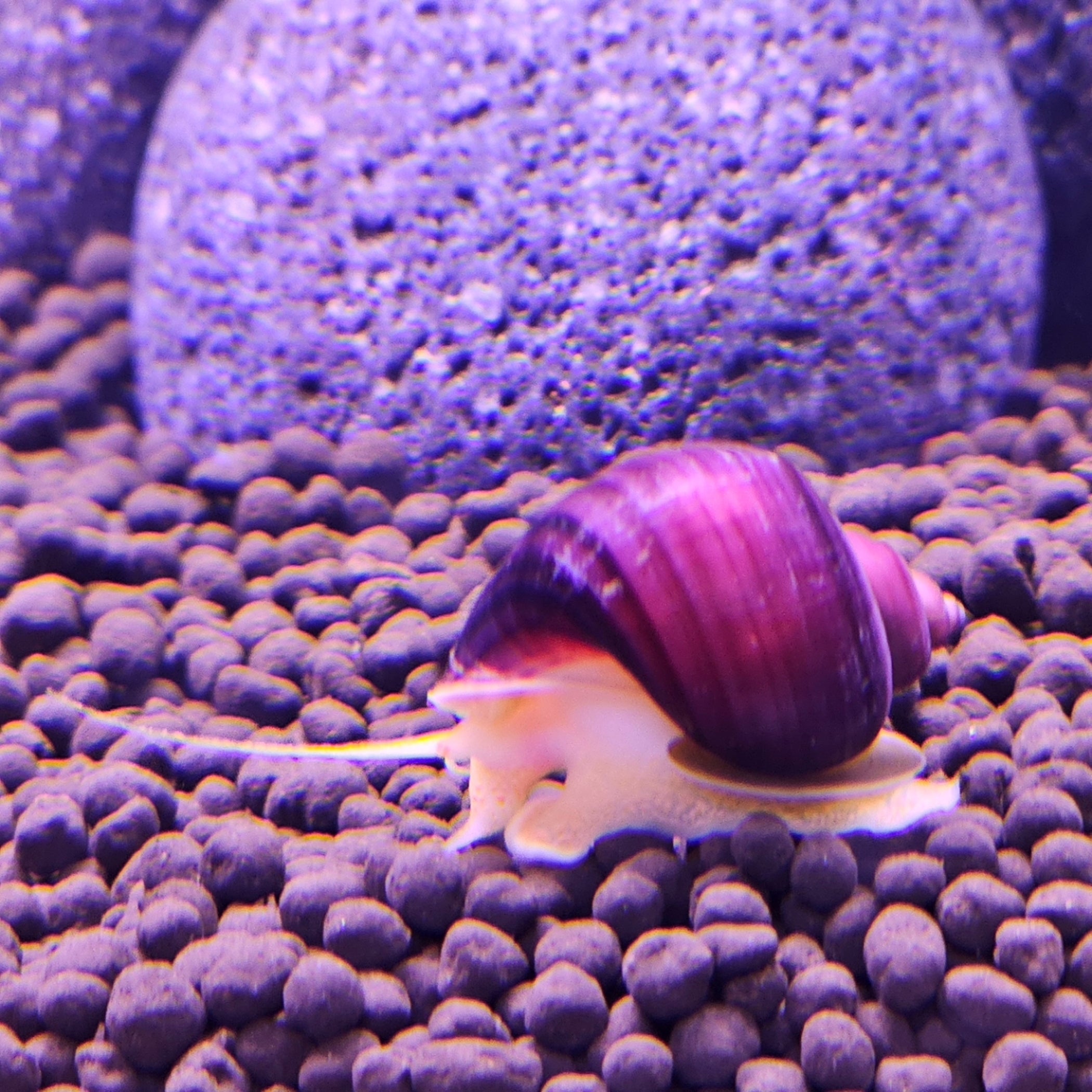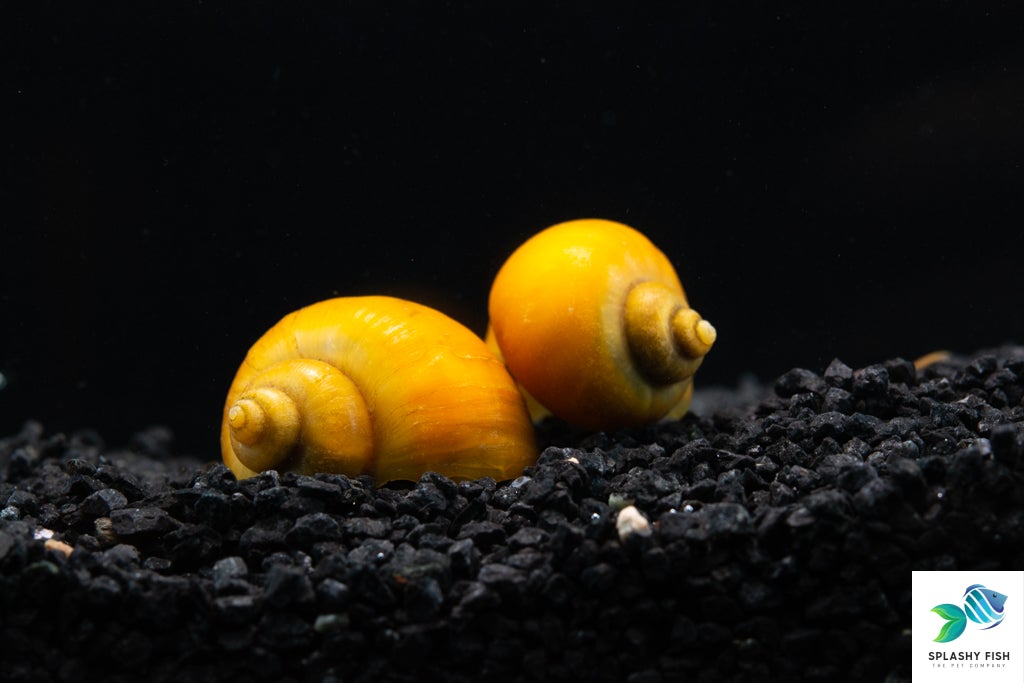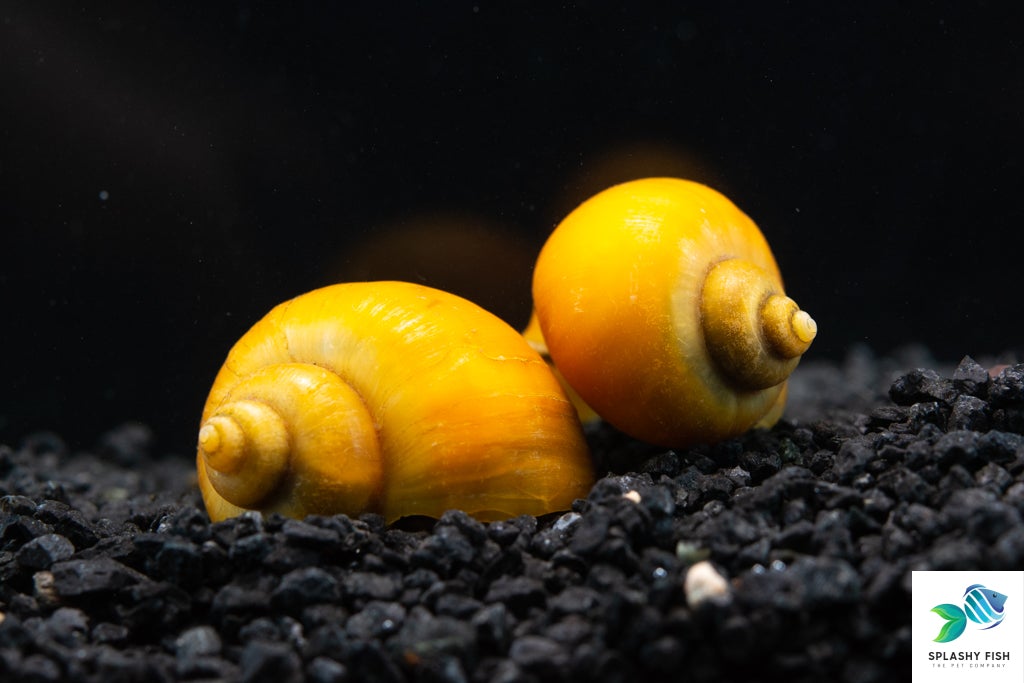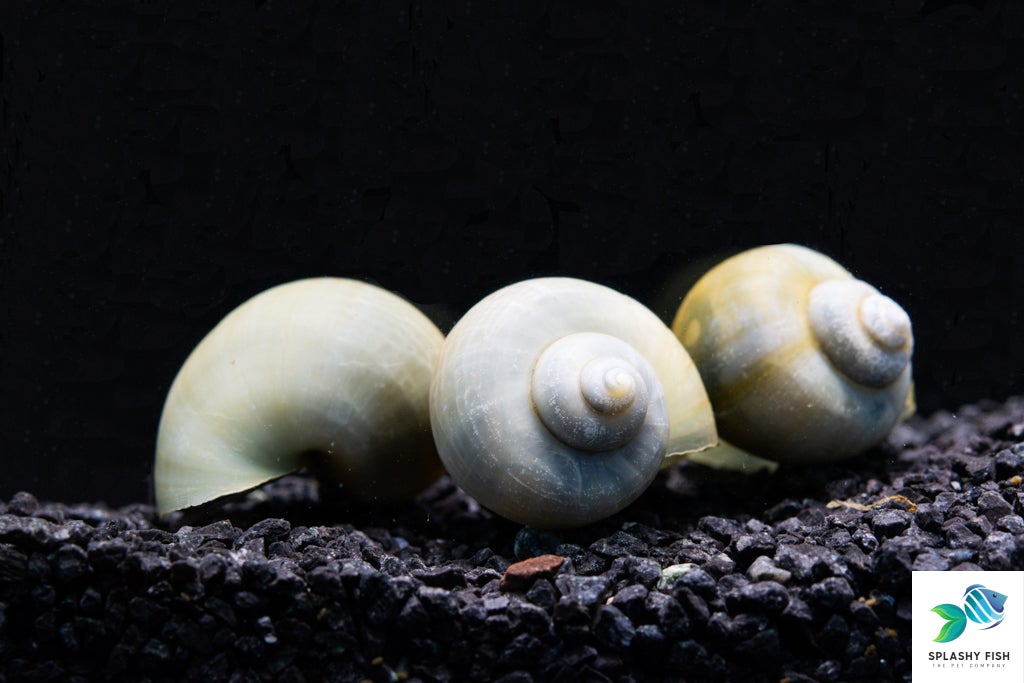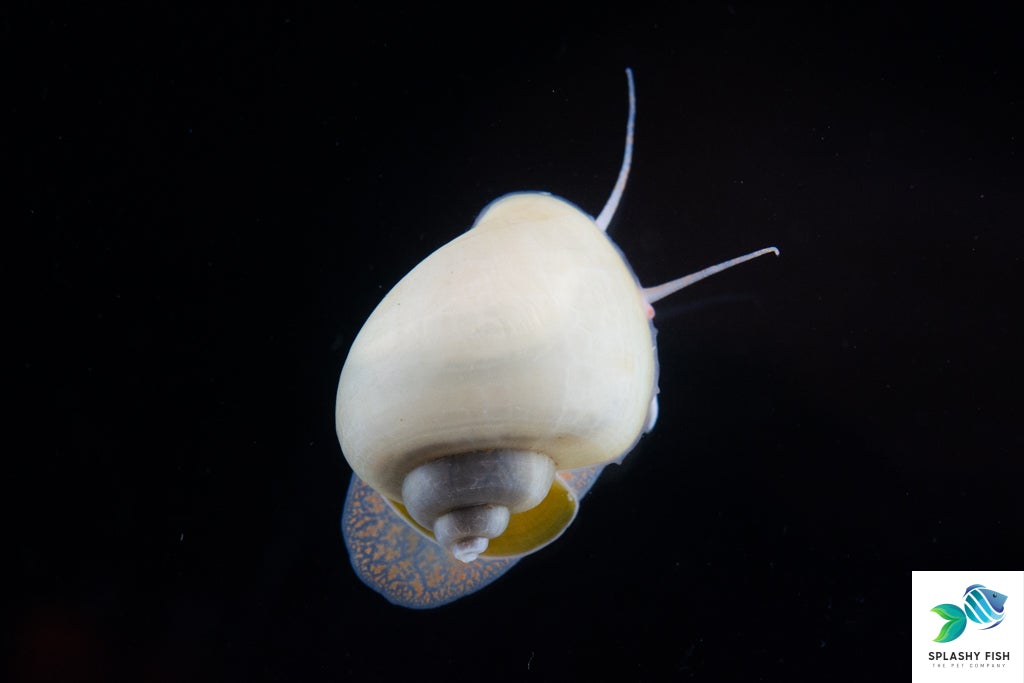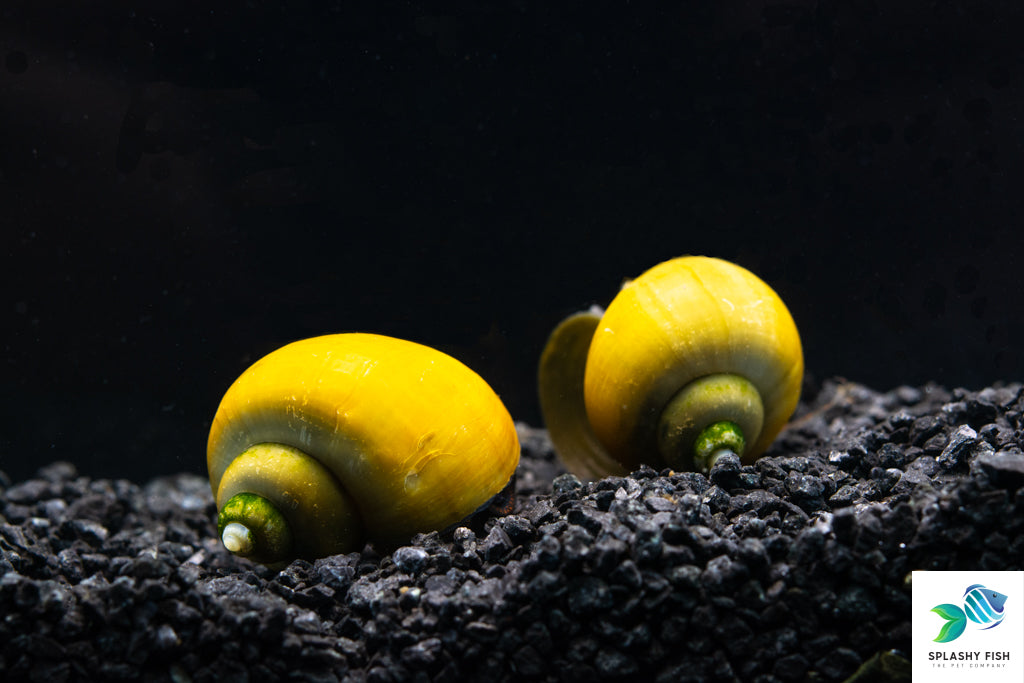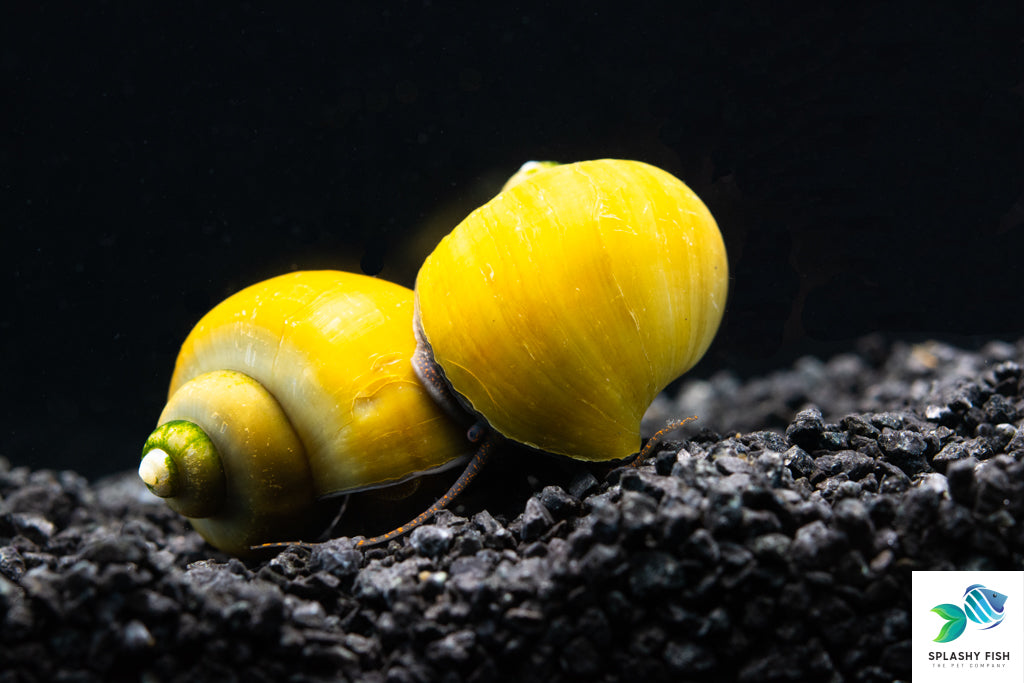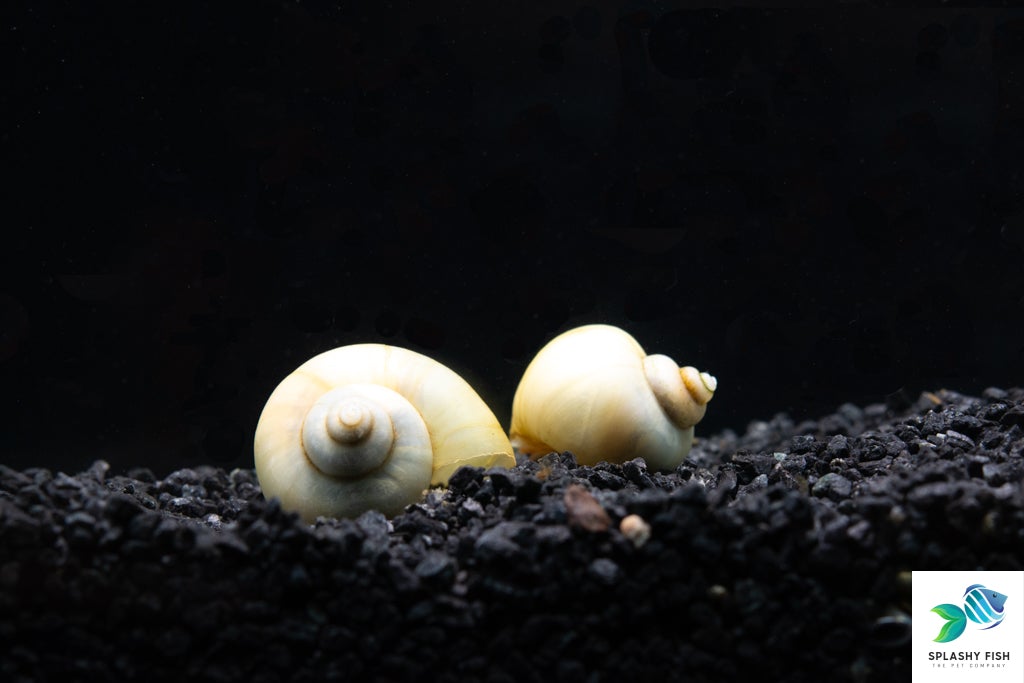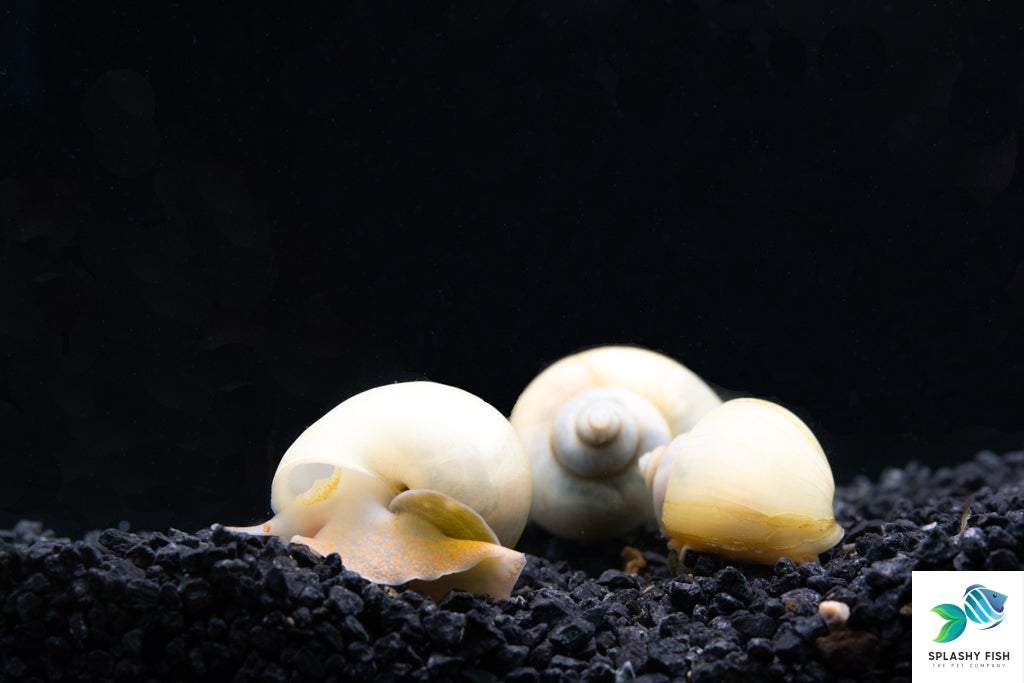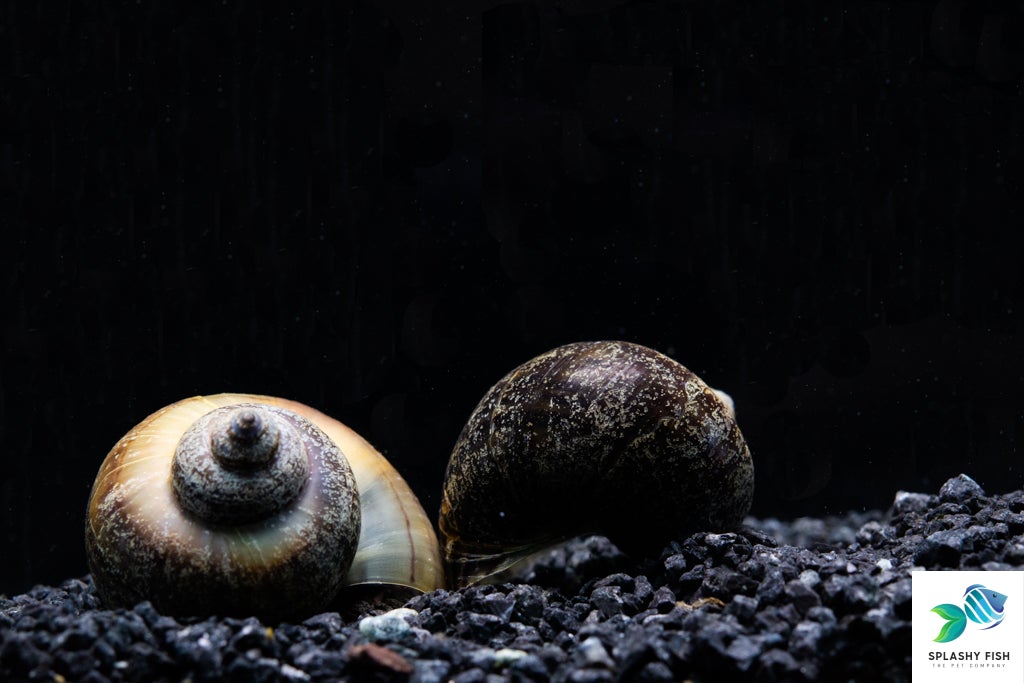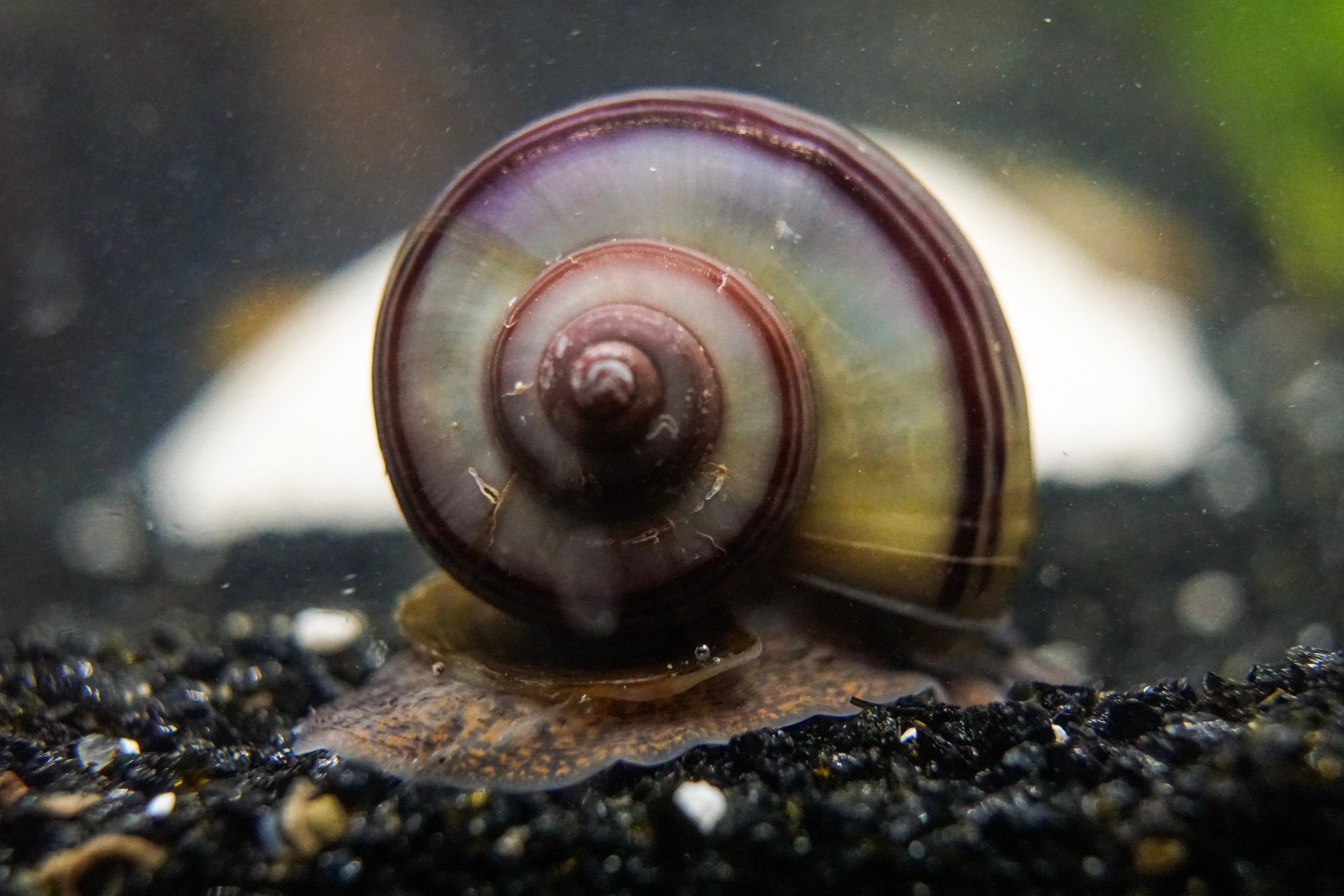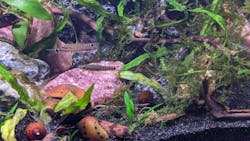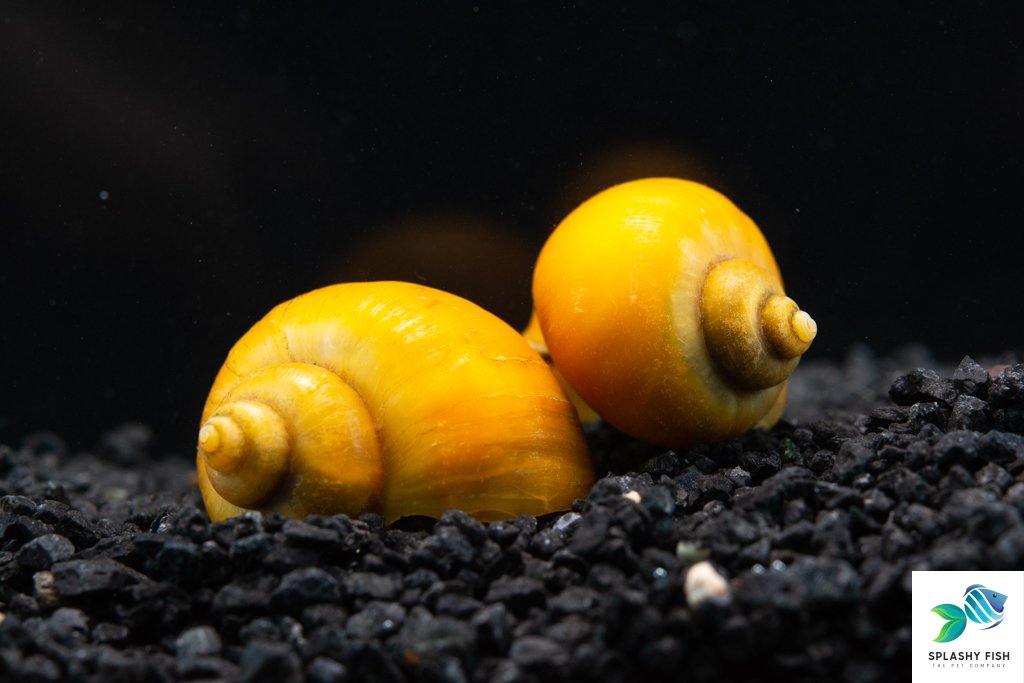
Mystery Snail
Mystery Snails (Pomacea bridgesii) are a popular and attractive addition to many aquariums, offering a unique and interesting addition to any aquatic setup. These small, hardy snails are known for their easy care requirements and beautiful, colorful shells.
In addition to adding visual appeal to your tank, Mystery Snails are also excellent at controlling algae growth and helping to keep your tank clean. These hardworking invertebrates will happily munch on excess food and debris, helping to keep your tank looking its best.
When it comes to caring for your Mystery Snails, it's important to provide them with a suitable habitat that meets their needs. This includes a tank with plenty of hiding places, clean water, and a reliable source of food. Mystery Snails are omnivorous and will eat a variety of foods including flakes, pellets, and fresh vegetables. Regular water changes and the use of a good quality aquarium filter will also help to ensure the health and well-being of your snails.
Overall, Mystery Snails are a low-maintenance and rewarding addition to any aquarium. With their beautiful shells and helpful cleaning habits, they are sure to be a hit with both novice and experienced aquarists alike.
At Splashy Fish Store, our Mystery snails for sale are carefully hand-selected and quarantined before shipping to ensure the highest quality when the order comes to our customers. Visit us to buy these Mystery snails online or at our aquarium store in Virginia for more other freshwater snails for sale, freshwater shrimp for sale, freshwater fish for sale, and live aquatic plants for sale.
Mystery Snails Frequently Asked Questions FAQs
Will Mystery Snails eat aquarium plants?
No, Mystery Snails are not known for eating healthy aquarium plants. They mainly feed on algae, decaying plant matter, and leftover fish food. However, they may nibble on dying or soft plant leaves, but they won’t harm live, healthy plants in your tank.
Can Mystery Snails live with Bettas?
Yes, Mystery Snails can generally live peacefully with Betta fish. Bettas may sometimes show curiosity, but most will ignore the snails. Ensure your Betta is not overly aggressive, and provide hiding spots for the snails in case your Betta becomes territorial.
How many Mystery Snails per gallon?
The general rule of thumb is to keep one Mystery Snail per 5 gallons of water. Overcrowding can lead to a build-up of waste, affecting water quality. For a 10-gallon tank, two Mystery Snails would be ideal, leaving space for other tank inhabitants.
The Enigmatic World of Mystery Snails: Unraveling the Secrets of these Fascinating Creatures
In the depths of aquatic habitats, a mysterious and captivating creature dwells - the mystery snail. With their vibrant shells and intriguing behavior, these enigmatic snails have long fascinated both casual onlookers and expert biologists. The world of mystery snails is one of secrets waiting to be unraveled, and in this article, we will embark on a journey to discover the truth behind these fascinating creatures. Mystery snails are known for their unique ability to solve the puzzles of survival in various aquatic ecosystems. From their reproductive strategies to their feeding habits, every aspect of their existence has evolved to withstand the challenges of their environment. Delving into their intricate social lives and their remarkable adaptability, we will uncover the secrets that make mystery snails such successful inhabitants of the aquatic world. Join us as we dive deep into the world of mystery snails, exploring their diverse species and habitats, shedding light on their distinctive diets, and uncovering the underlying mechanisms behind their mesmerizing behaviors. Get ready to discover the hidden wonders of these captivating creatures as we peel back the layers of their secretive lives.
Anatomy and Physical Characteristics of Mystery Snails
Mystery snails, also known as apple snails, are large freshwater snails belonging to the Ampullariidae family. They are characterized by their unique anatomy and physical features:
Shell
- The most prominent feature of mystery snails is their beautiful, rounded shell.
- The shell is typically brown or olive green in color, often with intricate patterns or bands.
- It is made of calcium carbonate and protects the snail's soft body.
Operculum
- Mystery snails possess an operculum, a trapdoor-like structure that seals the opening of their shell when they retract inside.
- The operculum helps protect the snail from predators and desiccation.
Body
- The snail's body is soft and unsegmented.
- It consists of a head, foot, and visceral mass.
- The head has two retractable tentacles, eyes, and a mouth.
- The foot is muscular and allows the snail to move and attach to surfaces.
Feeding Apparatus
- Mystery snails have a radula, a tongue-like structure lined with tiny teeth.
- The radula is used to scrape algae and other food particles from surfaces.
Respiratory System
- Mystery snails are air-breathing snails and have a modified lung called a pulmonary cavity.
- They periodically surface to the water's surface to breathe air through a respiratory siphon.
Reproductive System
- Mystery snails are hermaphrodites, meaning they have both male and female reproductive organs.
- They lay large, round eggs that are often attached to aquatic plants or other submerged surfaces.
Habitat and Natural Behavior of Mystery Snails
Mystery snails are found in a variety of freshwater habitats, including ponds, lakes, rivers, and marshes. They prefer slow-moving or still waters with an abundance of aquatic vegetation. Mystery snails are adaptable creatures and can tolerate a wide range of water conditions, including varying pH levels and temperatures.
In their natural habitat, mystery snails play an important role in the ecosystem. They help to keep the water clean by filtering out algae and other organic matter. Mystery snails are also a food source for various predators, including fish, birds, and turtles.
Mystery snails are generally peaceful creatures and do not pose a threat to other animals. They are known for their slow and deliberate movements. Mystery snails spend most of their time crawling along the bottom of the water body, grazing on algae and other food particles. They also periodically surface to the water's surface to breathe air through their respiratory siphon.
Mystery snails are fascinating creatures to observe. Their unique behavior and ability to adapt to various environments make them a popular choice for aquariums and terrariums.
Feeding Habits and Diet of Mystery Snails
Mystery snails are opportunistic omnivores, meaning they will eat a wide variety of aquarium plants and animal matter. Their diet typically consists of:
- Algae: Mystery snails are voracious algae eaters and will consume all types of algae, including green algae, brown algae, and red algae.
- Aquatic plants: Mystery snails will eat soft, tender aqua plants, such as duckweed, water lettuce, and hornwort.
- Detritus: Mystery snails will also eat detritus, which is decaying organic matter found at the bottom of the water body.
- Small invertebrates: Mystery snails may also eat small invertebrates, such as worms, insect larvae, and crustaceans.
Mystery snails play an important role in the ecosystem by helping to keep the water clean and free of algae. They are also a food source for various predators.
In captivity, mystery snails can be fed a variety of foods, including:
- Fresh vegetables: Mystery snails love to eat fresh vegetables, such as carrots, zucchini, and spinach.
- Algae wafers: Algae wafers are a commercial food that is specifically designed for snails.
- Freeze-dried bloodworms: Freeze-dried bloodworms are a protein-rich food that mystery snails enjoy.
- Live food: Mystery snails may also be fed live food, such as worms, insect larvae, and crustaceans.
It is important to provide mystery snails with a varied diet to ensure that they are getting all the nutrients they need. Mystery snails should be fed small amounts of food several times per week.
Reproduction and Lifecycle of Mystery Snails
Mystery snails are hermaphroditic, meaning they have both male and female reproductive organs. This allows them to reproduce without the need for a mate. However, mystery snails can also reproduce sexually if a mate is available.
When reproducing sexually, mystery snails will first engage in a courtship ritual. This involves the two snails touching and stroking each other with their tentacles. Once the snails are ready to mate, they will exchange sperm packets.
After mating, the female mystery snail will lay her eggs in a gelatinous mass that is attached to an aquatic plant or other submerged surface. The eggs will hatch into tiny snails after about two weeks.
The baby mystery snails will then grow and develop through several stages before reaching adulthood. It takes about six months for mystery snails to reach sexual maturity.
Mystery snails can live for up to five years in captivity. In the wild, their lifespan is typically shorter due to predation and other environmental factors.
Key Points:
- Mystery snails are hermaphroditic and can reproduce both sexually and asexually.
- When reproducing sexually, mystery snails engage in a courtship ritual before exchanging sperm packets.
- The female mystery snail lays her eggs in a gelatinous mass that is attached to an aquatic plant or other submerged surface.
- The eggs will hatch into tiny snails after about two weeks.
- It takes about six months for mystery snails to reach sexual maturity.
- Mystery snails can live for up to five years in captivity.
Common species of mystery snails
Mystery snails are fascinating freshwater aquarium snails renowned for their stunning shell patterns and gentle dispositions. They come in a wide range of species, each boasting unique shell colors and sizes. Here are some of the most common species of mystery snails:
Blue Mystery Snail
The Blue Mystery Snail captivates with its mesmerizing deep blue or turquoise shell. They are a beautiful addition to any aquarium, resembling precious gemstones when they move around.
Gold Mystery Snail
The Gold Mystery Snail shines with its golden yellow or orange shell. Their radiant shells are a visual delight, reminiscent of shimmering gold coins.
Jade Mystery Snail
The Jade Mystery Snail boasts a captivating dark green or olive green shell. Their shells are reminiscent of precious jade stones, bringing a touch of nature's elegance to the aquarium.
Black Mystery Snail
The Black Mystery Snail's striking black or dark brown shell exudes an air of mystery and intrigue. Their shells, like polished obsidian, add a touch of sophistication to the aquarium tank.
Purple Mystery Snail
The Purple Mystery Snail mesmerizes with its deep purple or reddish-purple shell. Their shells resemble vibrant amethysts, adding a pop of color to the underwater landscape.
Ivory Mystery Snail
The Ivory Mystery Snail possesses a delicate and elegant creamy white or ivory shell. Their shells, like fine porcelain, contribute a touch of grace and refinement to the aquarium.
Mystery snails are generally peaceful and slow-moving, making them ideal inhabitants for community aquariums. They maintain a balanced diet of algae, plants, and detritus, contributing to the overall health of the aquarium ecosystem. Watching them glide effortlessly through the water, displaying their spectacular shells, is a captivating sight that brings tranquility and wonder to any aquarium enthusiast.
Care and maintenance of mystery snails as pets
Provide a tank that is at least 5 gallons per snail.
Snails need plenty of space to move around and explore, so it's important to provide them with a tank that is at least 5 gallons per snail. A larger tank is always better, as it will give your snails more room to swim and play.
Fill the tank with clean, dechlorinated water.
Snails are very sensitive to water quality, so it's important to fill their tank with clean, dechlorinated water. You can use a water conditioner to remove chlorine and chloramine from your tap water.
Add a substrate of sand or gravel to the bottom of the tank.
Snails need a substrate to burrow in and hide under. Aqua Soil, Sand or gravel is a good option for snail substrate, as it is easy to clean and won't harm your snails.
Add plants and decorations to the tank to provide hiding places and enrichment.
Snails love to explore and hide, so it's important to add plenty of plants and aquarium decorations to their tank. Plants also help to keep the water clean and provide oxygen. Mystery snail loves Amazon Sword, Java Fern, Anubias, and Aquarium Moss.
Maintain the water temperature between 75 and 80 degrees Fahrenheit.
Snails are tropical animals, so they need warm water to thrive. The ideal water temperature for snails is between 75 and 80 degrees Fahrenheit.
Keep the pH level between 7.0 and 8.0.
Snails need a slightly alkaline pH level to survive. The ideal pH level for snails is between 7.0 and 8.0.
Feed the snails a varied diet of fresh vegetables, algae wafers, freeze-dried bloodworms, and live food.
Snails are omnivores, so they need a varied diet to stay healthy. Fresh vegetables, algae wafers, freeze-dried bloodworms, and live food are all good options for snail food.
Clean the tank regularly to remove waste and debris.
Snails produce a lot of waste, so it's important to clean their tank regularly to remove waste and debris. You should clean the tank at least once a week.
Monitor the snails for signs of illness or distress.
Snails are very sensitive to changes in their environment, so it's important to monitor them for signs of illness or distress. If you notice any changes in your snail's behavior, appearance, or appetite, you should contact a veterinarian immediately.
Common Issues and Diseases in Mystery Snails
Mystery snails are generally hardy creatures, but they can still be susceptible to certain issues and diseases. Some of the most common problems include:
- Shell damage: Mystery snails can damage their shells if they fall or are dropped. Shell damage can also be caused by sharp objects in the aquarium or by aggressive tankmates.
- Infections: Mystery snails can be infected by bacteria, fungi, or parasites. Infections can cause a variety of symptoms, such as lethargy, loss of appetite, and discoloration of the shell.
- Nutritional deficiencies: Mystery snails need a diet that is rich in calcium and other minerals. A lack of these nutrients can lead to health problems, such as weak shells and stunted growth.
- Overcrowding: Mystery snails can become stressed if they are kept in an overcrowded aquarium. Overcrowding can lead to health problems, such as aggression and disease.
Preventing and treating common issues and diseases in mystery snails
There are a number of things you can do to prevent and treat common issues and diseases in mystery snails. These include:
- Providing a healthy environment: Mystery snails need a clean, well-filtered aquarium with plenty of hiding places. The water should be hard and alkaline, with a pH of 7.5 to 8.5.
- Offering a nutritious diet: Mystery snails should be fed a variety of foods, including algae, fresh vegetables, and commercial snail food.
- Avoiding overcrowding: Mystery snails should not be kept in an overcrowded aquarium. A good rule of thumb is to keep no more than one mystery snail per gallon of water.
- Quarantining new snails: New snails should be quarantined for at least two weeks before being added to the main aquarium. This will help to prevent the introduction of diseases.
- Treating infections: If a mystery snail becomes infected, it should be treated with an appropriate medication.
With proper care and maintenance, mystery snails can live long and healthy lives. By following these tips, you can help to prevent and treat common issues and diseases in your mystery snails.
Interesting facts and myths about mystery snails
Facts
- Mystery snails are hermaphroditic, meaning they have both male and female reproductive organs.
- Mystery snails can lay up to 100 eggs at a time.
- Mystery snails can live for up to 5 years in captivity.
- Mystery snails are very good at cleaning up algae in aquariums.
- Mystery snails are also known to eat decaying plant matter and detritus.
- Mystery snails can change the color of their shells to match their surroundings.
Myths
- Mystery snails are not poisonous.
- Mystery snails do not carry diseases that can harm humans.
- Mystery snails do not need to be fed live food.
- Mystery snails do not need to be kept in a tank with a heater.
- Mystery snails do not need to be kept in a tank with a filter.
Conclusion: The wonders of mystery snails and why they make great pets
In conclusion, mystery snails are captivating creatures that add a touch of wonder and beauty to any aquarium. Their intricate shells, gentle nature, and algae-eating habits make them ideal pets for both novice and experienced aquarists alike.
If you're looking to add a unique and charming addition to your aquarium, consider getting a mystery snail for sale. These fascinating creatures are relatively easy to care for and can bring years of joy and entertainment.
So, why not embrace the wonders of mystery snails and give them a loving home in your aquarium? You won't regret it!




















